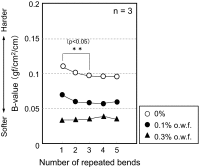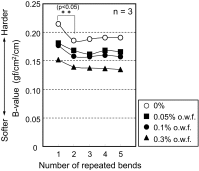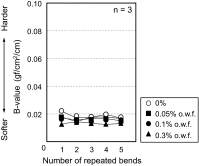Elucidation of Softening Mechanism in Rinse Cycle Fabric Softeners. Part 1: Effect of Hydrogen Bonding
- PMID: 26766897
- PMCID: PMC4700061
- DOI: 10.1007/s11743-015-1732-4
Elucidation of Softening Mechanism in Rinse Cycle Fabric Softeners. Part 1: Effect of Hydrogen Bonding
Abstract
Most softening agents, such as rinse cycle fabric softeners, used by consumers at home contain cationic surfactants that have two long alkyl chains as their main component. The softening mechanism on fibers, especially cotton, has not yet been scientifically established, despite the market prevalence of fabric softeners for decades. One explanation for the softening effect is that the friction between fibers is reduced. According to this explanation, the fiber surfaces are coated by layers of alkyl chains. Because of the low coefficient of friction between alkyl chain layers of low surface energy, the fibers easily slide against one another yielding softer cotton clothing. However, no direct scientific evidence exists to prove the validity of this explanation. The softening mechanism of cotton yarn is discussed in this paper. Bending force values of cotton yarn treated with several concentrations of softener are measured by bend testing, and cotton and polyester yarns are compared. Results indicate that increases in cotton yarn hardness after natural drying are caused by cross-linking among inner fibers aided by bound water. This type of bound water has been known to exist even after 2 days of drying at 25 °C and 60 % relative humidity. Yarn dried in vacuo is soft, similar to that treated with softener. Thus, some of the softening effect caused by fabric softeners on cotton can be attributed to the prevention of cross-linking by bound water between cotton fibers.
Keywords: Bound water; Cotton; Fabric softener; Fiber cross-linking; Hydrogen bonding; Polyester; Softening mechanism.
Figures















References
-
- Iwasawa Y, Umezawa Y, Sawada S, Tsujii K. Handbook of intersurface chemistry and engineering. Japan: NTS; 2001.
-
- Okumura O, Yokoi K. J Surf Sci Japan. 1986;6:5411–5414.
-
- Seno M, Tsujii K. Kaimenkasseizainokagakuto Ouyou. Japan: Dai Nippon Toshyo; 1995. p. 88.
-
- Takeuchi H. Kaimenkasseizai. Japan: Sangyo Tosho; 1999.
-
- Katayama T. Ifukukanrinokagaku. Tokyo: Kenpakusha; 2003.
LinkOut - more resources
Full Text Sources
Other Literature Sources
